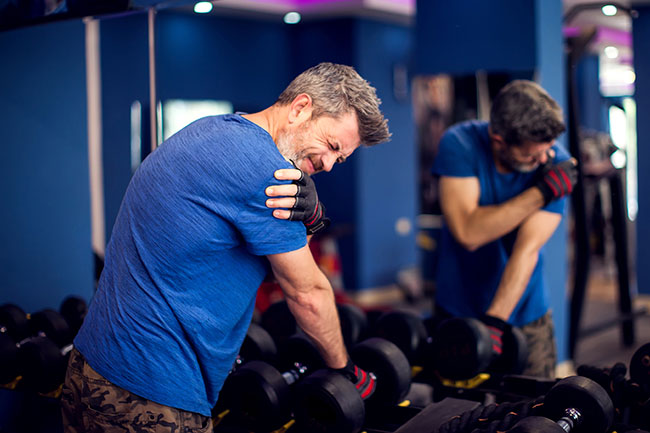
If you’ve heard the term rotator cuff, chances are that you may think it as some vague body part near your shoulder that nobody seems to be able to describe well. Actually your rotator cuff is made up of four muscles that work together to allow your shoulder to move while keeping it stable. Like your hip, your shoulder joint is made up of a ball and socket. But unlike your hip your shoulder socket is very shallow, and depends on having strong muscles to hold your upper arm in place while allowing for full range of motion.
The four muscles that make up your rotator cuff include:
- The supraspinatus muscle, which is a small but powerful muscle that sits on the upper ridge of your scapula, the two large wing-shaped bones in your upper back. Supraspinatus is engaged when you raise your arm from the side. Even though your supraspinatus is in your upper back, it’s a frequent cause of shoulder pain. Supraspinatus problems are usually associated with pain felt as a sharp or shooting sensation that’s felt in the upper part of your arm when you lift it out to the side and upwards. Frequently you’ll feel a painful “catch” where you can’t lift your arm any higher.
- Just below the ridge of your scapula is the infraspinatus muscle. Its job it to rotate your arm outward as if you were hugging a really big tree.
- When you actually close your arms to give a hug, you’re engaging the subscapular muscle. It lines the inside, or chest-side, of your scapula.
- Near the back and bottom of your armpit is a small muscle called Teres minor. It connects the outside of your scapula to the top of your arm bone (humerus). Teres minor is an important muscle in stabilizing your shoulder, but also helps with outward rotation.
The number of ways that you can injure your shoulder are endless. Trauma from an accident or a fall, poor posture, overuse, and the aging process are all common causes. A rotator cuff injury happens when one or more of the muscles become pulled or torn, you develop inflammation in the tendons, or when swelling of the tissues causes impingement of the tendons where they pass under the acromion, which is the bone at the top of your shoulder.
Treating Rotator Cuff Injuries
Standard Western treatment for rotator cuff injuries may involve pain medications, anti-inflammatory medications, steroid injections, physical therapy, and in extreme cases, surgery. Practitioners of Chinese medicine look at these kinds of injuries in a little different light. In Chinese medicine, pain conditions are diagnosed as a kind of obstruction or blockage. They usually involve hampered circulation, swelling, impingement, and a loss of range of motion. If you’re struggling with rotator cuff pain and choose to treat it with acupuncture and Chinese medicine, your practitioner would provide treatments not only to treat the pain, but also to increase circulation, decrease inflammation, increase your range of motion, and promote healing. Not surprisingly, many people with rotator cuff issues have found that acupuncture can offer effective treatment.
In addition to acupuncture, your practitioner may incorporate other healing tools into your treatment plan. They may use heat therapy as a way to improve circulation in the area, loosen tight muscles, and to increase your range of motion. Electrical stimulation, which involves adding a painless electric current to the acupuncture needles, may be used to augment pain relief. Your practitioner may also choose to use a technique called cupping. This involves placing clear glass or plastic cups around your shoulder and/or back into which suction has been created as a way to increase circulation and promote healing. Also effective in treating shoulder problems is a kind of bodywork called Tui Na. This involves pulling, pressing, and massaging the tissues in a way that involves the acupuncture points and pathways around your shoulder. Tui Na can be helpful to loosen tight muscles, increase circulation, improve your range of motion, and support the healing process.
The bottom line is that a rotator cuff injury can be painful, complex, and feel as though they will never heal. However, your shoulder injury doesn’t need to sideline you for good. Acupuncture and Chinese medicine can play an important role in treating shoulder injuries, even when you feel like you’ve tried everything. Your acupuncture practitioner has a number of healing tools to relieve your pain, improve your range of motion, reduce inflammation, and speed up the healing process.

Cindy Chamberlain is an acupuncturist in Overland Park, KS and the founder of Eastern Healing Solutions, LLC. She is licensed in Kansas and Missouri and has been practicing traditional Chinese medicine since 1996.


